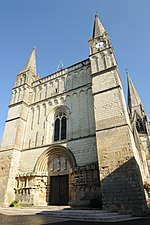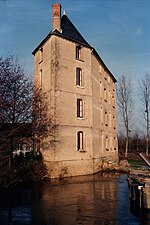Le Puy-Notre-Dame
| Le Puy-Notre-Dame | ||
|---|---|---|

|
|
|
| region | Pays de la Loire | |
| Department | Maine-et-Loire | |
| Arrondissement | Saumur | |
| Canton | Doué-la-Fontaine | |
| Community association | Saumur Val de Loire | |
| Coordinates | 47 ° 8 ′ N , 0 ° 14 ′ W | |
| height | 32-106 m | |
| surface | 15.87 km 2 | |
| Residents | 1,192 (January 1, 2017) | |
| Population density | 75 inhabitants / km 2 | |
| Post Code | 49260 | |
| INSEE code | 49253 | |
 Le Puy-Notre-Dame - town view |
||
Le Puy-Notre-Dame is a French commune with 1,192 inhabitants (at January 1, 2017) in the department of Maine-et-Loire in the region of Pays de la Loire , near the border with Deux-Sevres , which has the region Nouvelle-Aquitaine heard. The name is probably derived from the Latin word podium , which means something like 'elevation' or 'hill'. During the French Revolution , the place was renamed and given the name Puy-la-Montagne .
location
Le Puy-Notre-Dame is not far from the river Thouet , a southern tributary of the Loire , and is about 23 kilometers (driving distance) in a south-westerly direction from Saumur .
Population development
| year | 1968 | 1975 | 1982 | 1990 | 1999 | 2006 | 2017 |
| Residents | 1639 | 1500 | 1472 | 1322 | 1236 | 1302 | 1192 |
economy
Viticulture has been practiced in the area since Gallo-Roman times (5th / 6th centuries) and of course in the Middle Ages, but at the end of the 19th century a phylloxera ( phylloxera ) introduced from America destroyed almost all vines in Europe. The plague could only be contained by grafting European grape varieties onto resistant American rhizomes.
Even today, the economic life of the place is largely characterized by viticulture: Loire white and red wines are produced. The red wines from Le Puy have had their own Saumur Puy-Notre-Dame appellation since 2006 . The comparatively light red wines from the Loire are mostly served chilled - even in restaurants.
Furthermore, the cultivation of mushrooms plays an important role in the economic life of the municipality. The underground of Le Puy is perforated with a multitude of corridors and chambers in which tufa stones were broken up into the 19th century to build houses and churches. This man-made artificial cave system has a constant temperature of 12 ° C - ideal for growing mushrooms.
history
There was already a Romanesque church here in the 11th century, which was consecrated to the Virgin Mary ( ecclesia beatae Mariae de Podio ). Through a reliquary foundation of Wilhelm IX. , Duke of Aquitaine , who had returned from the 1st Crusade , the church received a 'Belt of Mary' made of silk and linen. This approximately 1.50 meter long ribbon was greatly admired in the following years - it was said to help with childbirth pains and favor the birth of male successors. So the French kings Louis IX came. and Louis XI. as well as Anne de Bretagne and Anna of Austria and asked for help with the birth of their sons.
In 1478, on the instructions of Louis XI. a chapter of canons installed, who had to take care of all matters of the church, the relics and the pilgrims. This made the pilgrimage church of Le Puy a collegiate church .
During the Hundred Years War (1337-1453) the city was surrounded with a wall; in the Huguenot Wars (1562–1598) the city walls were razed - the church remained intact.
- Attractions
- Notre-Dame Church : In the second half of the 12th century, Eleanor of Aquitaine , the granddaughter of William IX, began building a new and larger church. Its west facade with its many blind arcades and the side tower attachments is somewhat reminiscent of the cathedral of Poitiers , Eleanor's native city. Inside, the church has three aisles, has elegant bundle pillars and shows central nave vaults in the Angevin style - these so-called 'Anjou vaults' differ from the usual Gothic rib vaults in that there are apex ribs which, however, do not run through at the same height; The individual yokes of the nave are rather separated by lower-lying belt arches and thus form a very peculiar intermediate thing between a vault and a dome. The two side aisles are almost the same height as the central nave; But their yokes only have a normal four-part vault without crown ribs and belt arches. The straight end of the choir has two side by side instead of a central window. The capitals and keystones of the church are richly decorated with figures, animals and vegetal ornaments, but you need binoculars to see all the details. In the choir area there are still some nice chairs; a scene in the Misericordien shows a 'noble gentleman' drinking straight from the barrel instead of waiting for the wine to be served in the cup.
- The Moulin de Couché is a four- story watermill from the 19th century. In order to better drain the water of the stream, the building is pointed on one side, which gives it the appearance of a ship's bow.
- In the city there is a beautiful building of a former Franciscan convent ( couvent des cordeliers ) from the 16th century.
- The cemetery chapel ( Chapelle St-Sauveur ) dates from the 15th century and has a small bell gable .
- As a station on a parallel route on the pilgrimage route to Santiago de Compostela ( Via Turonensis ), the place also has some houses with scallops on the facades.
literature
- Le Patrimoine des Communes de Maine-et-Loire . Flohic Editions, Volume 2, Paris 2001, ISBN 2-84234-117-1 , pp. 849-851.



